2023 SUBARU BRZ tires
[x] Cancel search: tiresPage 15 of 432
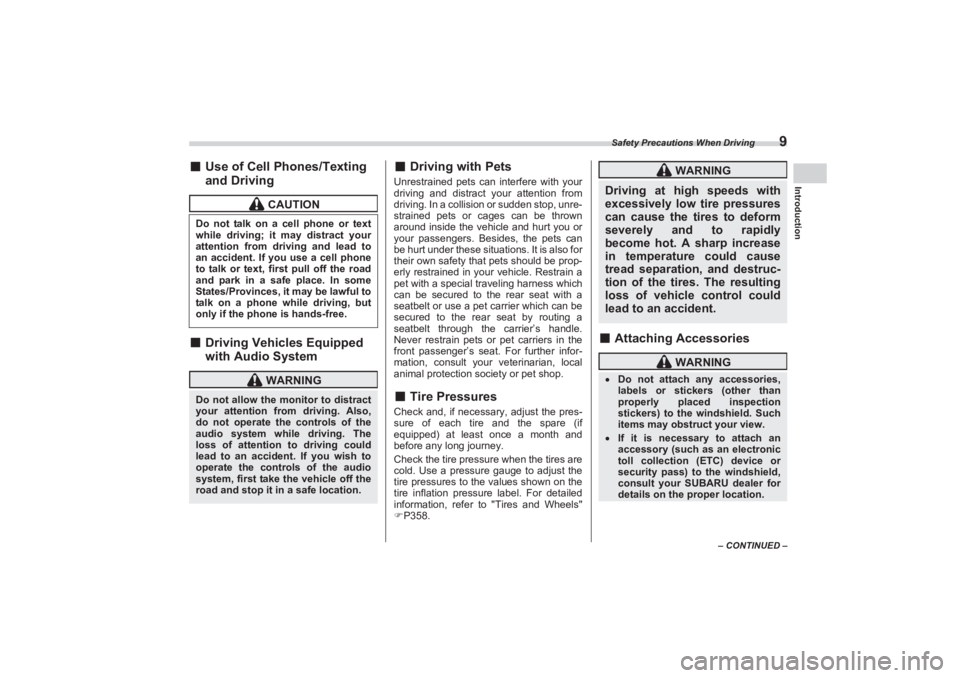
Safety Precautions When Driving
9
Introduction
– CONTINUED –
■Use of Cell Phones/Texting
and Driving■Driving Vehicles Equipped
with Audio System
■Driving with PetsUnrestrained pets can interfere with your
driving and distract your attention from
driving. In a collision or sudden stop, unre-
strained pets or cages can be thrown
around inside the vehicle and hurt you or
your passengers. Besides, the pets can
be hurt under these situations. It is also for
their own safety that pets should be prop-
erly restrained in your vehicle. Restrain a
pet with a special traveling harness which
can be secured to the rear seat with a
seatbelt or use a pet carrier which can be
secured to the rear seat by routing a
seatbelt through the carrier’s handle.
Never restrain pets or pet carriers in the
front passenger’s seat. For further infor-
mation, consult your veterinarian, local
animal protection society or pet shop.■ Tire PressuresCheck and, if necessary, adjust the pres-
sure of each tire and the spare (if
equipped) at least once a month and
before any long journey.
Check the tire pressure when the tires are
cold. Use a pressure gauge to adjust the
tire pressures to the values shown on the
tire inflation pressure label. For detailed
information, refer to "Tires and Wheels"
P358.
■ Attaching Accessories
CAUTION
Do not talk on a cell phone or text
while driving; it may distract your
attention from driving and lead to
an accident. If you use a cell phone
to talk or text, fi rst pull off the road
and park in a safe place. In some
States/Provinces, it may be lawful to
talk on a phone while driving, but
only if the phone is hands-free.
WARNING
Do not allow the monitor to distract
your attention from driving. Also,
do not operate the controls of the
audio system while driving. The
loss of attention to driving could
lead to an accident. If you wish to
operate the controls of the audio
system, first take the vehicle off the
road and stop it in a safe location.
WARNING
Driving at high speeds with
excessively low tire pressures
can cause the tires to deform
severely and to rapidly
become hot. A sharp increase
in temperature could cause
tread separation, and destruc-
tion of the tires. The resulting
loss of vehicle control could
lead to an accident.
WARNING
Do not attach any accessories,
labels or sticke rs (other than
properly placed inspection
stickers) to the windshield. Such
items may obstruct your view. If it is necessary to attach an
accessory (such as an electronic
toll collection (ETC) device or
security pass) to the windshield,
consult your SUBARU dealer for
details on the proper location.
BRZ_U.book 9 ページ 2022年3月29日 火曜日 午後3時59分
Page 20 of 432
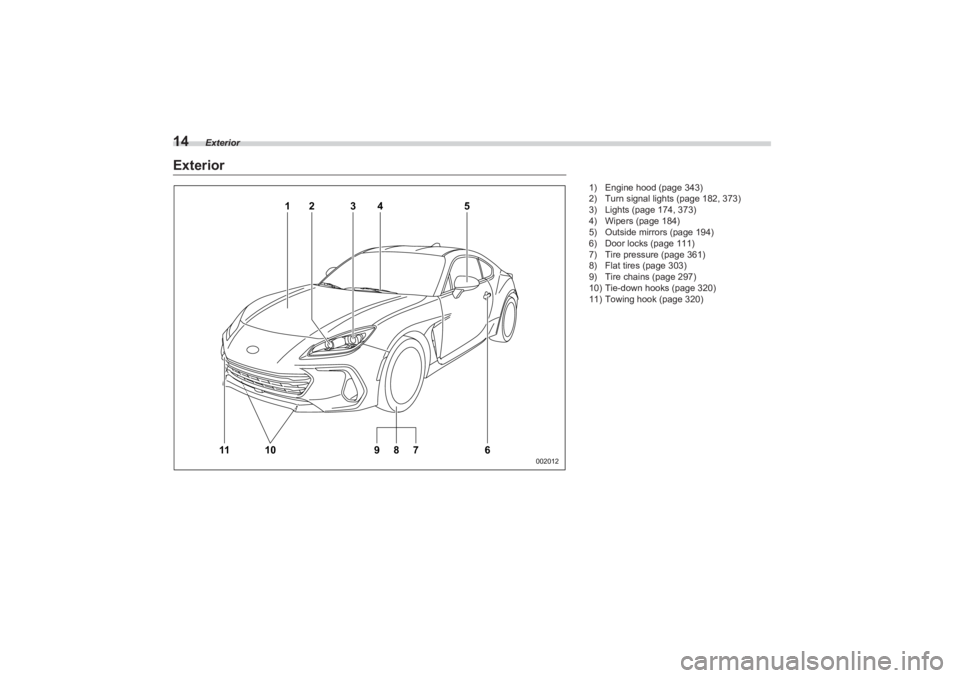
Exterior
14Exterior
1
11
4
5
3
2
10
8
76
9
002012
1) Engine hood (page 343)
2) Turn signal lights (page 182, 373)
3) Lights (page 174, 373)
4) Wipers (page 184)
5) Outside mirrors (page 194)
6) Door locks (page 111)
7) Tire pressure (page 361)
8) Flat tires (page 303)
9) Tire chains (page 297)
10) Tie-down hooks (page 320)
11) Towing hook (page 320)
BRZ_U.book 14 ページ 2022年3月29日 火曜日 午後3時59分
Page 52 of 432
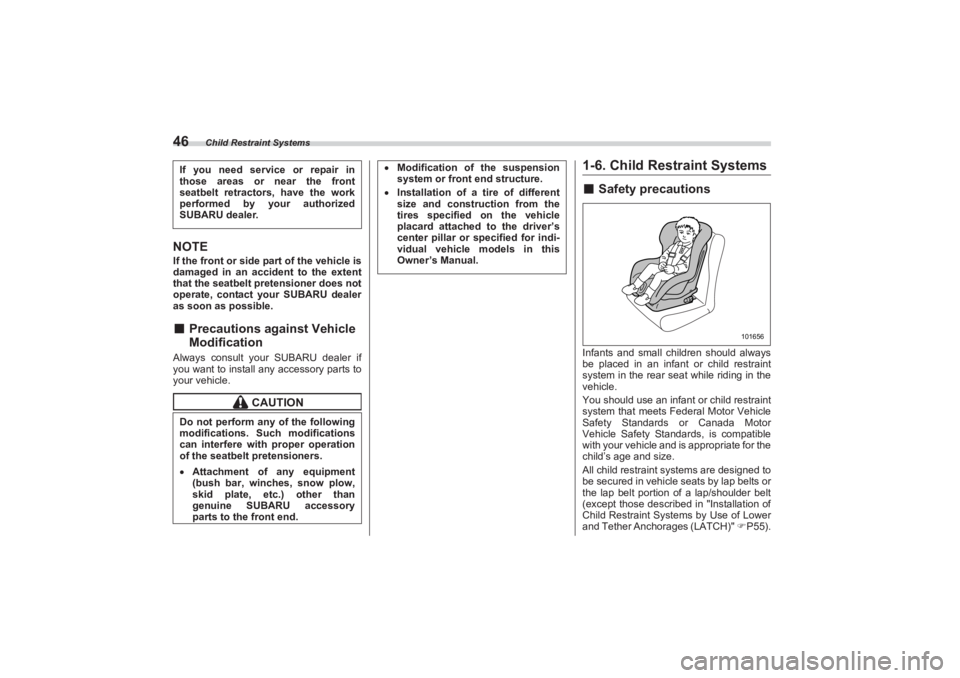
Child Restraint Systems
46NOTEIf the front or side part of the vehicle is
damaged in an accident to the extent
that the seatbelt pretensioner does not
operate, contact your SUBARU dealer
as soon as possible.■ Precautions against Vehicle
ModificationAlways consult your SUBARU dealer if
you want to install any accessory parts to
your vehicle.
1-6. Child Restraint Systems■ Safety precautionsInfants and small children should always
be placed in an infant or child restraint
system in the rear seat while riding in the
vehicle.
You should use an infant or child restraint
system that meets Federal Motor Vehicle
Safety Standards or Canada Motor
Vehicle Safety Standards, is compatible
with your vehicle and is appropriate for the
child’s age and size.
All child restraint systems are designed to
be secured in vehicle seats by lap belts or
the lap belt portion of a lap/shoulder belt
(except those described in "Installation of
Child Restraint Systems by Use of Lower
and Tether Anchorages (LATCH)" P55).
If you need service or repair in
those areas or near the front
seatbelt retractors, have the work
performed by your authorized
SUBARU dealer.
CAUTION
Do not perform any of the following
modifications. Such modifications
can interfere with proper operation
of the seatbelt pretensioners. Attachment of any equipment
(bush bar, winches, snow plow,
skid plate, etc.) other than
genuine SUBARU accessory
parts to the front end.
Modification of the suspension
system or front end structure. Installation of a tire of different
size and construction from the
tires specified on the vehicle
placard attached to the driver’s
center pillar or specified for indi-
vidual vehicle models in this
Owner’s Manual.
101656
BRZ_U.book 46 ページ 2022年3月29日 火曜日 午後3時59分
Page 89 of 432
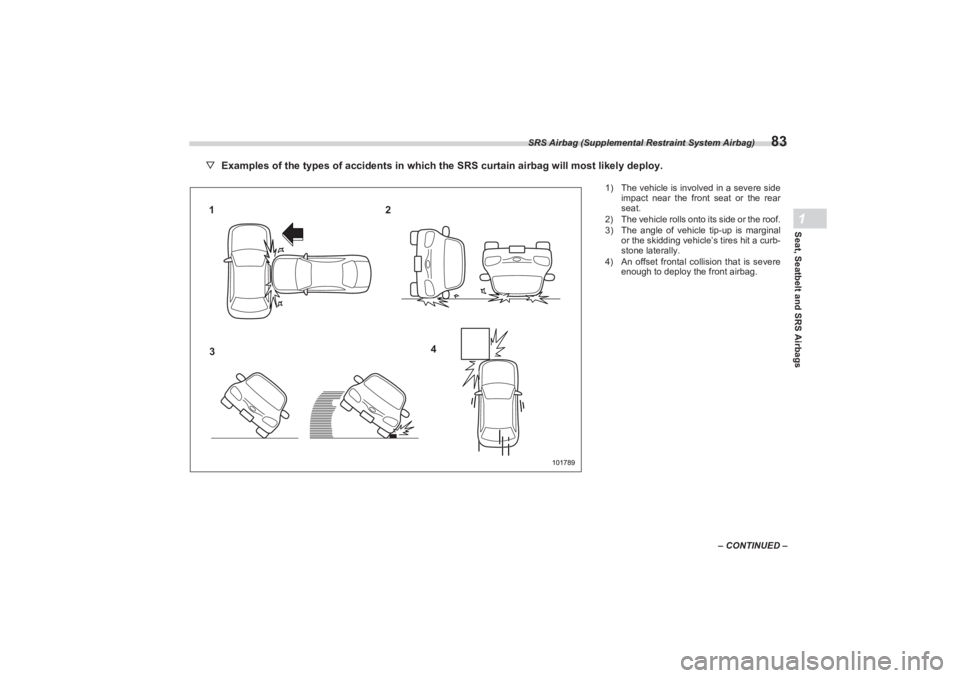
SRS Airbag (Supplemental Restraint System Airbag)
83
Seat, Seatbelt and SRS Airbags1
– CONTINUED –
▽Examples of the types of accidents in which the SRS curtain airbag will most likely deploy.
101789
3
12
4
1) The vehicle is involved in a severe side
impact near the front seat or the rear
seat.
2) The vehicle rolls onto its side or the roof.
3) The angle of vehicle tip-up is marginal or the skidding vehicle’s tires hit a curb-
stone laterally.
4) An offset frontal collision that is severe
enough to deploy the front airbag.
BRZ_U.book 83 ページ 2022年3月29日 火曜日 午後3時59分
Page 96 of 432

SRS Airbag (Supplemental Restraint System Airbag)
90
Always consult your SUBARU dealer if
you want to install any accessory parts on
your vehicle.
■ How to Contact the Vehicle
Manufacturer concerning
Modifications for Persons
with Disabilities That May
Affect the Advanced Airbag
SystemChanging or moving any parts of the front
seats, rear seat, se atbelts, front bumper,
front side frame, radiator panel, instru-
ment panel, combination meter, steering
wheel, steering colu mn, tire, suspension
or floor panel can affect the operation of
the SUBARU advanced airbag system. If
you have any questions, you may contact
the following SUBARU distributors.
Subaru of America, Inc.
Customer Advocacy Department
One Subaru Drive
P.O. Box 9103
Camden, NJ 08101-9877
1-800-SUBARU3 (1-800-782-2783)
Subaru Hawaii
2850-A Pukoloa St.,
Honolulu, HI 96819
877-215-0338
- Installation of additional elec- trical/electronic equipment
such as a mobile two-way
radio on or near the SRS
airbag system components
and/or wiring is not advisable.
This could interfere with
proper operation of the SRS
airbag system.- Modifications on or inside the
door panels for the purpose of
a speaker replacement or
sound insulation
The impact sensors, which detect
the pressure of an impact, are
located in the doors. Do not
modify any components of the
doors or door trims, such as the
addition of door speakers for
example. Any modifications to
the doors will create a risk of the
airbag system becoming inopera-
tive or unintended airbag deploy-
ment.
CAUTION
Do not perform any of the following
modifications. Such modifications
can interfere with proper operation
of the SRS airbag system.
Attachment of any equipment
(bush bar, winches, snow plow,
skid plate, etc.) other than
genuine SUBARU accessory
parts to the front end. Modification of the suspension
system or front end structure. Installation of a tire of different
size and construction from the
tires specified on the vehicle
placard attached to the driver’s
center pillar or specified for indi-
vidual vehicle models in this
Owner’s Manual. Attachment of any equipment
(side steps or side sill protectors,
etc.) other than genuine SUBARU
accessory parts to the side body.
BRZ_U.book 90 ページ 2022年3月29日 火曜日 午後3時59分
Page 144 of 432
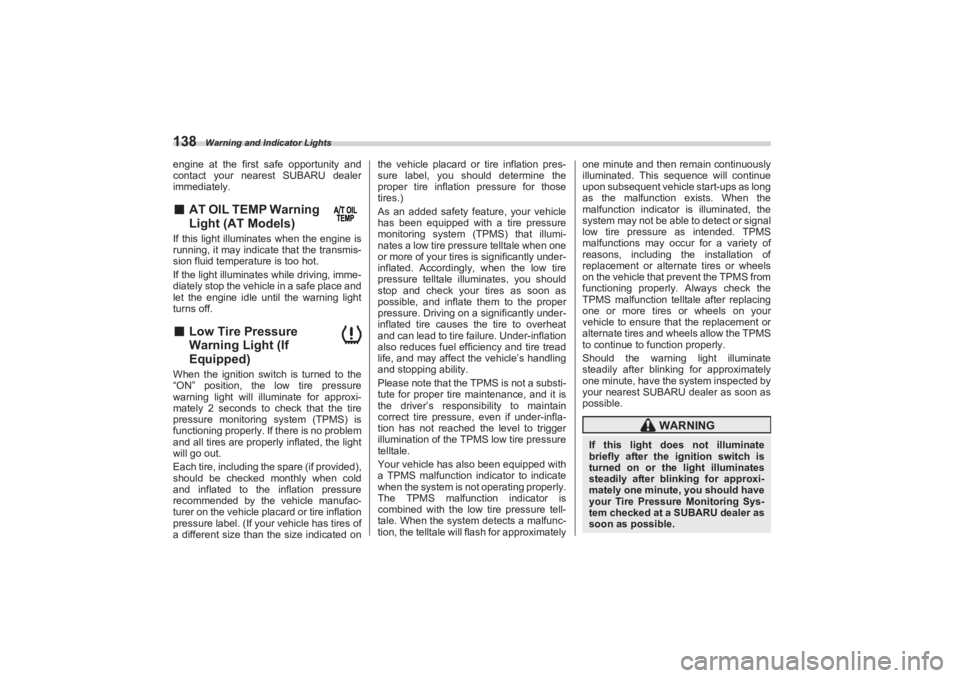
Warning and Indicator Lights
138engine at the first safe opportunity and
contact your nearest SUBARU dealer
immediately.■ AT OIL TEMP Warning
Light (AT Models) If this light illuminates when the engine is
running, it may indicate that the transmis-
sion fluid temperature is too hot.
If the light illuminates while driving, imme-
diately stop the vehicle in a safe place and
let the engine idle until the warning light
turns off.■ Low Tire Pressure
Warning Light (If
Equipped)When the ignition switch is turned to the
“ON” position, the low tire pressure
warning light will illuminate for approxi-
mately 2 seconds to check that the tire
pressure monitoring system (TPMS) is
functioning properly. If there is no problem
and all tires are properly inflated, the light
will go out.
Each tire, including the spare (if provided),
should be checked monthly when cold
and inflated to the inflation pressure
recommended by the vehicle manufac-
turer on the vehicle placard or tire inflation
pressure label. (If your vehicle has tires of
a different size than the size indicated on the vehicle placard or tire inflation pres-
sure label, you should determine the
proper tire inflation pressure for those
tires.)
As an added safety feature, your vehicle
has been equipped with a tire pressure
monitoring system (TPMS) that illumi-
nates a low tire pressure telltale when one
or more of your tires is significantly under-
inflated. Accordingly, when the low tire
pressure telltale illuminates, you should
stop and check your tires as soon as
possible, and inflate them to the proper
pressure. Driving on a significantly under-
inflated tire causes the tire to overheat
and can lead to tire failure. Under-inflation
also reduces fuel efficiency and tire tread
life, and may affect the vehicle’s handling
and stopping ability.
Please note that the TP MS is not a substi-
tute for proper tire maintenance, and it is
the driver’s responsibility to maintain
correct tire pressure, even if under-infla-
tion has not reached the level to trigger
illumination of the TPMS low tire pressure
telltale.
Your vehicle has also been equipped with
a TPMS malfunction indicator to indicate
when the system is no t operating properly.
The TPMS malfunction indicator is
combined with the low tire pressure tell-
tale. When the system detects a malfunc-
tion, the telltale will flash for approximately one minute and then remain continuously
illuminated. This sequence will continue
upon subsequent vehicle start-ups as long
as the malfunction exists. When the
malfunction indicator is illuminated, the
system may not be able to detect or signal
low tire pressure as intended. TPMS
malfunctions may occur for a variety of
reasons, including the installation of
replacement or alternate tires or wheels
on the vehicle that prevent the TPMS from
functioning properly. Always check the
TPMS malfunction telltale after replacing
one or more tires or wheels on your
vehicle to ensure that the replacement or
alternate tires and wheels allow the TPMS
to continue to function properly.
Should the warning light illuminate
steadily after blinking for approximately
one minute, have the system inspected by
your nearest SUBARU dealer as soon as
possible.
WARNING
If this light does not illuminate
briefly after the ig nition switch is
turned on or the light illuminates
steadily after blinking for approxi-
mately one minute, you should have
your Tire Pressure Monitoring Sys-
tem checked at a SUBARU dealer as
soon as possible.
BRZ_U.book 138 ページ 2022年3月29日 火曜日 午後3時59分
Page 145 of 432

Warning and Indicator Lights
139
Instruments and Controls3
– CONTINUED –
If this light illuminates while driving,
never brake suddenly. Instead, per-
form the following procedure. Oth-
erwise an accident involving
serious vehicle damage and serious
personal injury could occur.1) Keep driving straight ahead while
gradually reducing speed.2) Slowly pull off the road to a safe
place.If this light still illuminates while
driving after adjusting the tire pres-
sure, a tire may have significant
damage and a fast leak that causes
the tire to lose air rapidly. If you
have a flat tire, replace it with a
spare tire as soon as possible.
When a spare tire is mounted or a
wheel rim is replaced without the
original pressure sensor/transmitter
being transferred, the Low tire pres-
sure warning light will illuminate
steadily after blinking for approxi-
mately one minute. This indicates
the TPMS is unable to monitor all
four road wheels. Contact your
SUBARU dealer as soon as possi-
ble for tire and sensor replacement
and/or system resetting. If the light
illuminates steadily after blinking
for approximately one minute,
promptly contact a SUBARU dealer
to have the system inspected.
CAUTION
The tire pressure monitoring sys-
tem is NOT a substitute for manu-
ally checking tire pressure. The tire
pressure should be checked period-
ically (at least monthly) using a tire
gauge. After any change to tire
pressure(s), the tire pressure moni-
toring system will not re-check tire
inflation pressures until the vehicle
is first driven mo re than 25 mph (40
km/h). After adjusting the tire pres-
sures, increase the vehicle speed to
at least 25 mph (40 km/h) to start the
TPMS re-checking of the tire infla-
tion pressures. If the tire pressures
are now above the severe low pres-
sure threshold, the low tire pres-
sure warning light should turn off a
few minutes later. Therefore, be
sure to install the specified size for
the front and rear tires.
BRZ_U.book 139 ページ 2022年3月29日 火曜日 午後3時59分
Page 160 of 432
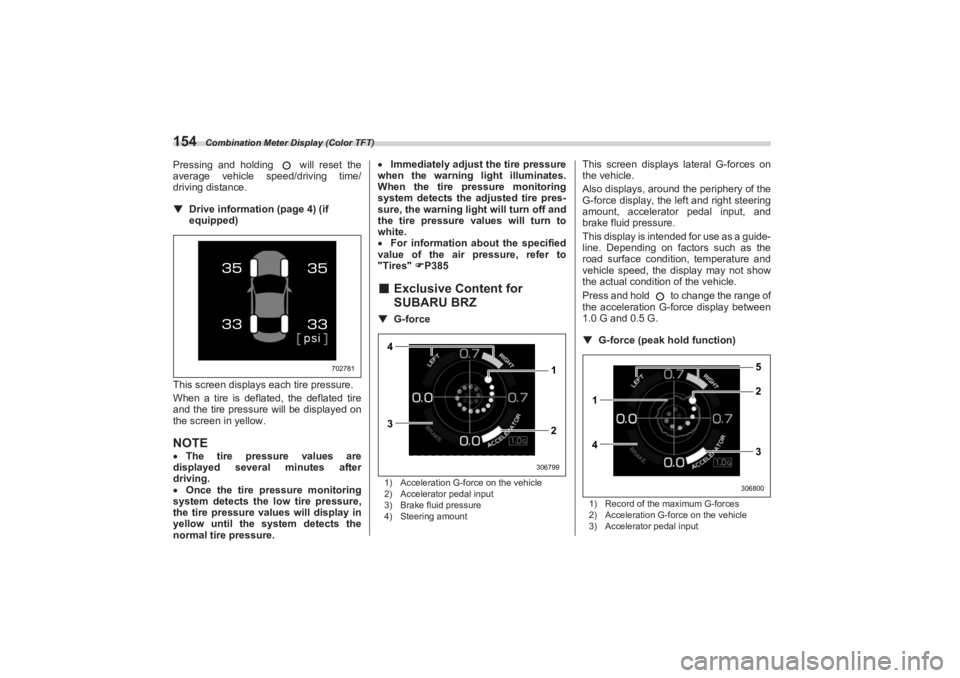
Combination Meter Display (Color TFT)
154Pressing and holding will reset the
average vehicle speed/driving time/
driving distance.▼ Drive information (page 4) (if
equipped)
This screen displays each tire pressure.
When a tire is deflated, the deflated tire
and the tire pressure will be displayed on
the screen in yellow.NOTE The tire pressure values are
displayed several minutes after
driving.
Once the tire pressure monitoring
system detects the low tire pressure,
the tire pressure values will display in
yellow until the system detects the
normal tire pressure.
Immediately adjust the tire pressure
when the warning light illuminates.
When the tire pr essure monitoring
system detects the adjusted tire pres-
sure, the warning ligh t will turn off and
the tire pressure values will turn to
white.
For information about the specified
value of the air pressure, refer to
"Tires" P385
■ Exclusive Content for
SUBARU BRZ▼ G-force1) Acceleration G-force on the vehicle
2) Accelerator pedal input
3) Brake fluid pressure
4) Steering amount
This screen displays lateral G-forces on
the vehicle.
Also displays, around the periphery of the
G-force display, the left and right steering
amount, accelerator pedal input, and
brake fluid pressure.
This display is intended for use as a guide-
line. Depending on factors such as the
road surface conditi on, temperature and
vehicle speed, the display may not show
the actual condition of the vehicle.
Press and hold to change the range of
the acceleration G-force display between
1.0 G and 0.5 G.
▼ G-force (peak ho ld function)1) Record of the maximum G-forces
2) Acceleration G-force on the vehicle
3) Accelerator pedal input
702781
4
3 1
2
306799
1
42 5
3
306800
BRZ_U.book 154 ページ 2022年3月29日 火曜日 午後3時59分